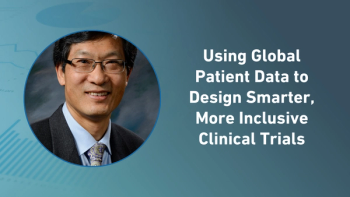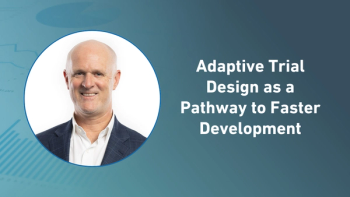
Applied Clinical Trials Supplements
- Supplements-05-01-2011
- Volume 0
- Issue 0
Personalized Medicine
How will the end of one-size-fits-all medicine effect the clinical trial industry?
Personalized medicine is an approach to drug development that seeks to deliver the right drug to the right patient, at the right time. Although a personalized approach to treating patients has existed in one form or another for many years, the mapping of the human genome in 2003 elevated its application to promising new heights. Commonly referred to as 4P medicine, the approach is characterized by the ability to deliver personalized, predictive, and proactive solutions for patients' healthcare needs, all while encouraging their participation in the process.
(LEONARD MC LANE/GETTY IMAGES)
This move away from a one-size-fits-all mentality towards customized treatment represents a paradigm shift, not only for drug developers, but also for other key stakeholders such as regulators, payers, and patients who are involved in helping shape its direction. Each party is poised to reap benefits, but the promise of a brighter future does not come without its challenges.
This article will provide a brief overview of the benefits and challenges associated with personalized medicine in the clinical setting, and more specifically to the operational conduct of oncology studies—one therapeutic area that is most likely to benefit.
Current model
It is common knowledge that the present clinical drug development model is broken and in dire need of repairs. There is no shortage of drug candidate discoveries, but unfortunately the vast majority of these fail to prove efficacy in the clinical setting. What's even more troubling is that many compounds in development are failing in later stages (Phase III), which represents as much as 40 percent of the entire clinical drug development budget.1 Only one in 10 compounds are approved for use; in the oncology space, the attrition rate is thought to be much higher. The biggest inefficiencies of the traditional model are largely attributed to the improper selection of drug targets. With thin pipelines and blockbuster drugs coming off patent, pharmaceutical companies are seeing their profits being eroded by low-cost generic competitors. These companies can no longer afford to sustain a drug development model that has become increasingly costly, unpredictable, and inefficient.
Solution?
Many believe that pharmacogenetics, a key component to personalized medicine, could provide the solution to the industry's chronic ailment. Pharmacogenetics is used to understand the genetic profile of a specific person's disease. For drug developers, this means being able to pinpoint which patients are likely to respond best to a treatment, thereby increasing the likelihood of demonstrating drug efficacy in clinical testing. It can also help explain adverse events from a genetic and molecular standpoint.
"If you want to understand a disease, genetics gives you the opportunity to shine a bright light into the darkness of our ignorance so we can find better ways to prevent and treat," says Francis Collins, MD, the former Director of the National Center for Human Genome Research within the NIH, who is now Director of the NIH.2
With the prospect of increasing the likelihood of success, while reducing the time and costs associated with clinical trials, it is no surprise that companies are actively exploring these opportunities. According to Price Waterhouse Coopers, in 2007, 20 to 30 percent of Phase II clinical trials incorporated pharmacogenetics; this number is thought to be even higher in oncology.3 Cancer drug development is a likely candidate to be at the forefront of the pharmacogenetic approach, due primarily to the fact that it is a disease of mutant genes. Furthermore, tissue samples are readily available from biopsied tumors and sophisticated tests have subsequently been developed for precision disease diagnosis. There are also inspiring success stories, such as the development of Herceptin; Gleevec; and Oncotype DX™, a diagnostic test that determines the likelihood of breast cancer recurrence in women and the magnitude of benefit from certain types of chemotherapy and hormonal therapy.
Since approximately 50 percent of the biopharmaceutical industry's early stage drug development pipeline is currently in oncology3 and that the price tag per compound exceeds $2.3 billion for multi-therapeutic drugs,4 hedging a bet on the promise of personalized medicine seems like a reasonable thing to do from an economic perspective (Figure 1). But how will it alter the landscape from a clinical operations perspective?
Figure 1. Research and development costs nearly doubled in just seven years.
Benefits
First and foremost, this new paradigm is likely to dramatically enhance patient recruitment performance. Given the fact that less than 5 percent of adult cancer patients in the United States participate in clinical trials,5 it's no surprise that only 50 percent of sites meet their recruitment targets and up to 30 percent fail to recruit any patients at all.6 The prospect of attracting more patients is an obvious benefit. While the subject of poor patient recruitment cannot be attributed to a single factor, we do know that patients have lost faith in the current drug development model. Under the hospices of personalized medicine, where a patient's disease would be diagnosed with a pharmacogenetic approach, we can expect patients to strongly reconsider their position.
Patients are going to see the possibility of deriving a direct benefit from study participation, a drastic change from the status quo, and can expect to experience fewer side effects. With this in mind, it is reasonable to conclude that patient interest may be revived, and subsequently, more patients will opt to take part in clinical trials.
A great example of this trend is a collaborative initiative currently underway between the Susan Love Research Foundation, the Avon Foundation for Women, and the National Cancer Institute's cancer Biomedical Informatics Grid (caBIG) that is leveraging web 2.0 technology to create the first online cohort of one million women to support biomedical research. Members of the Love/Avon Army of Women are invited to join the study cohort and may respond to periodic secure online questionnaires concerning their health history. Authorized researchers may access the database and design study protocols based on the clinical profiles and data of potential research participants.7
A survey conducted by KGT Group asked 199 oncologists or hematologists and 100 clinical trial professionals across the United States for their views on personalized medicine trends in cancer treatment and research. Fifty-three percent of respondents thought that recruiting patients to clinical trials with targeted oncology therapies would be less difficult than for large scale randomized trials with more cytotoxic drugs.8
Complimenting this movement is the streamlining of patient deployment into trials, as the right patients are directed to trials they are best suited for. Because of the specific genetic characterization of disease, and the use of biomarkers as surrogate endpoints, personalized medicine trials will, for the most part, be shorter in duration and will require fewer patients. When adding all these factors together it is clear that important efficiencies will be attained. For drug developers, this means quicker and easier access to targeted patient populations as well as the prospect of arriving at positive, more meaningful results sooner. From an economic standpoint it is estimated that the adoption of pharmacogenetics in drug development could save drug companies as much as $335 million per drug according to a 2001 report by the Boston Consulting Group.9
Clinical investigative teams will have more interesting trials to propose to their patients based on more compelling science. This welcome change will undoubtedly inspire and motivate a group of clinical research professionals all to used to witnessing mass drug development failure. While enjoying their new and improved work environment, these teams will have to simultaneously embrace additional responsibility as they navigate the legal and ethical issues surrounding genetic testing. Consent forms will become increasingly complex and healthcare professionals will have to increase their understanding of the field of genetics in order to successfully manage patient concerns around the meaning of their genetic mutation, how their private information will be handled, and just who will access it. In summary, patient interest in new and improved trials will provide more opportunity for successful recruitment performance, but will be highly contingent on successful patient counseling.
Collaborative networks
As select centers become proficient in the conduct of personalized medicine trials, they will develop collaborative networks providing easy access for drug developers. Currently, large university teaching centers in industrialized countries are poised to take the lead. They have the knowledge, state of the art equipment and technology, as well as the clinical care and infrastructure to support sophisticated trials. Working with these centers of excellence is likely to result in a better harmonization of rules in this area. For the western hemisphere, which has been steadily losing clinical development projects to emerging markets, this is positive news particularly when taking into account that the value of the personalized medicine market represented by pharmaceutical, medical device, and diagnostic companies is estimated at $24 billion and is expected to grow by 10 percent annually reaching $42 billion by 2015.2
New landscape
Historically, the size of a clinical trial has been dictated by the phase of clinical research. As a compound moves through the various phases of research, the size of the trial increases. The personalized medicine approach will call for the replacement of a few large-scale trials with many smaller ones. Even in the Phase III setting, it is very possible that the landscape will consist of a conglomerate of smaller trials. Instead of running one trial with 50 patients, sites may very well find themselves conducting five trials of 10 patients each. Regardless of the size of a trial, the burden of certain administrative activities such as contract/budget review and negotiation, IRB submission, protocol and investigator brochure review, study meetings, and the like remain constant. In other words, the new model may have built-in efficiencies, but it will require more time and resources on the part of clinical investigative teams. Drug developers will have to support this shift with a revamped budgeting model that may include among other things, a higher monetary compensation for these administrative tasks. Ultimately, some of the costs saved by shorter development time lines will have to be re-injected to support the clinical development process.
Industry trends confirm that contract research organizations (CROs) will continue to play a key role in the clinical drug development process. The trend toward a greater number of smaller trials will force many CROs, particularly smaller ones, to adopt a more volume-based business model. Much like clinical investigative teams, their administrative burden will increase significantly. In this new world, CROs will need to attract more small trials to make up for fewer large ones. This in turn will demand greater sales and marketing efforts to generate the same amount of revenue. From an internal operations perspective, this will require more contract review and budget negotiations, more proposal writing, and more accounting for multiple clients and trials.
On the other side of the equation, it's no secret that drug developers have been tightening their belts and becoming much more price sensitive with regard to service provider budgets in an effort to cut costs. This may be detrimental to the overall efficiency of oncology trials, as tighter study budgets may force CROs to employ cheaper, less experienced workers who are not as well versed in the complexities of clinical trials coming down the pipe. In order for the new model to be sustainable, there will have to be some concessions made by both parties, but how this will eventually play out remains to be seen.
Drug developers are also bracing themselves for a drastic change in their business models. There is an awful lot riding on the hope that "niche-buster" drugs will command a high price for their efficacy in targeted patient populations and that they will succeed in capturing the lion's share of smaller, more select markets. Biopharmaceutical companies are hoping that the discovery of specific target therapies will lead to other drug development opportunities in which their research and development investments can be maximized.
Conclusion
The emergence of personalized medicine is having a significant impact on the process of drug discovery and development. The foundation is being laid for a healthcare system in which data will flow freely among all stakeholders, enabling researchers, clinicians, and patients to interact in new and more productive ways.
Advances in information technology coupled with the increasing popularity of social networking, has given patients access to a wealth of information that was previously only available from their local healthcare providers. Healthcare professionals will have to learn to share the playing field with these direct-to-patient communication channels as they begin to exert even greater influence on patients' opinions and treatment decisions.
These innovative efforts and initiatives provide a tremendous amount of hope for the future, but there is much speculation about how it will all play out. Will shorter development time lines and the opportunity to market highly targeted "niche-buster" drugs provide enough revenues to offset the increased operational budgets they will require? Only time will tell. One thing is certain: the current situation is not sustainable and that no single industry, company, or agency can fix it alone. It will require a collaborative commitment on behalf of all key stakeholders involved (Figure 2).
Figure 2. The implementation of personalized medicine requires the combination of several factors.
Denise Deakin, RN, BSc, is the President and co-founder of Scimega Research Inc.,
References
1. Organisation for Econonic Co-Operation and Development, report, "Pharmacogenetics: Opportunities and Challenges for Health Innovation", (November 12, 2009).
2. Price Waterhouse Coopers, report, "The New Science of Personalized Medicine: Translating the Promise into Practice," (October 2009).
3. ClinicalTrials.gov,
4. Wayne A. Rosenkrans, presentation, the Oncology Leadership Forum, Boston, MA, November 8, 2010.
5. Harris Interactive, "Misconceptions and Low Awareness Slow Recruitment for Cancer Clinical Trials," (October 18, 2000),
6. Ken Getz, "Is Investigative Site Feasibility Feasible?" Applied Clinical Trials, July 2008, 36-38..
7. The Age of Personalized Medicine, Innovation.org, a project of the Pharmaceutical Research and Manufacturers of America,
8. Peter Mansell, "Targeted Therapies are a Silver Lining in Oncology Trials," Pharma Times Online (December 02, 2009),
9. P. Tollman, P. Guy, J. Altshuler, A. Flanagan, and M. Steiner, "A Revolution in R&D: How Genomics and Genetics are Transforming the Biopharmaceutical Industry," The Boston Consulting Group,
Articles in this issue
over 14 years ago
CAM Use in Asia-Pacificover 14 years ago
How CROs Help Oncology Sponsors Produce Resultsover 14 years ago
Cancer Biomedical Informatics GridNewsletter
Stay current in clinical research with Applied Clinical Trials, providing expert insights, regulatory updates, and practical strategies for successful clinical trial design and execution.






.png)



.png)



.png)
.png)
